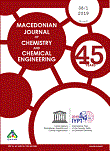Identification and quantification of phenolic compounds in pomegranate juices from eight Macedonian cultivars
DOI:
https://doi.org/10.20450/mjcce.2019.1775Keywords:
pomegranate, polyphenols, HPLC/MSAbstract
Punica granatum L. is one of the species enjoying growing interest due to its complex and unique chemical composition that encompasses the presence of anthocyanins, ellagic acid and ellagitannins, gallic acid and gallotannins, proanthocyanidins, flavanols and lignans. This combination is deemed responsible for a wide range of health-promoting biological activities.
This study was focused on the analysis of flavonoids, anthocyanins and phenolic acids in eight pomegranate varieties (Punica granatum) from Macedonia, in two consecutive years. Fruits from each cultivar were washed and manually peeled, and the juice was filtered. NaF (8.5 mg) was added to 100 ml juice as a stabilizer. The samples were centrifuged for 15 min at 3000 rpm and analyzed using an HPLC/DAD/MSn method that was optimized for determination of their polyphenolic fingerprints.
The dominant anthocyanin in all pomegranate varieties was cyanidin-3-glucoside followed by cyanidin and delphinidin 3,5-diglucoside. From the results, it can be concluded that the content of anthocyanins was higher in 2016 compared to 2017. But in contrast, the total content of non-colored polyphenols was around 10 times lower in 2016 compared to the amount found in the same samples in 2017.
References
H. Boeing, A. Bechthold, A. Bub, S. Ellinger, D. Haller, A. Kroke, E. Leschik-Bonnet, M. J. Müller, H. Oberritter, M. Schulze, P. Stehle, B. Watzl, Critical review: vegetables and fruit in the prevention of chronic diseases, Eur. J. Nutr., 51, 637–663 (2012).
DOI: 10.1007/s00394-012-0380-y.
C. G. Fraga, K. D. Croft, D. O. Kennedye, F. A. Tomás-Barberán, The effects of polyphenols and other bioactives on human health, Food Funct. (2019).
DOI: 10.1039/c8fo01997e
C. Manach, A. Scalbert, C. Morand, C. Rémésy, L. Jiménez, Polyphenols: food sources and bioavailability, Am. J. Clin. Nutr., 79, 727–747 (2004).
DOI: https://doi.org/10.1093/ajcn/79.5.727.
A. R. Tapas, D. M. Sakarkar, R. B. Kakde, Flavonoids as nutraceuticals: A review, Trop. J. Pharm. Res., 7, 1089–1099, (2008). DOI: http://dx.doi.org/10.4314/tjpr.v7i3.14693.
D. Rymon, Mapping features of the global pomegranate market, Acta Hortic., 890, 599−602 (2011).
DOI: 10.17660/ActaHortic.2011.890.84.
M. Viuda-Martos, J. Fernández-López, J. A. Pérez-Álvarez, Pomegranate and its many functional components as related to human health: A review, Compr. Rev. Food Sci. Food Saf., 9, 635−654 (2010).
DOI: https://doi.org/10.1111/j.1541-4337.2010.00131.x.
D. A. Kruger, Composition of pomegranate juice, J. AOAC Int., 95, 163−168 (2012).
U. A. Fischer, R. Carle, D. R. Kammerer, Identification and quantification of phenolic compounds from pomegranate (Punica granatum L.) peel, mesocarp, aril and differently produced juices by HPLC-DAD-ESI/MSn, Food Chem., 127, 807−821 (2011).
DOI: https://doi.org/10.1016/j.foodchem.2010.12.156.
F. Bonzanini, R. Bruni, G. Palla, N. Serlataite, A. Caligiani, Identification and distribution of lignans in Punica granatum L. fruit endocarp, pulp, seeds, wood knots and commercial juices by GC−MS, Food Chem., 117, 745−749 (2009).
DOI: 10.1016/j.foodchem.2009.04.057.
D. Del Rio, A. Rodriguez-Mateos, J. P. E. Spencer, M. Tognolini, G. Borges, C. Crozier, Dietary (Poly)phenolics in human health: structures, bioavailability and evidence of protective effects against chronic diseases, Antioxid. Redox. Signal., 18, 1818−1892 (2013). DOI: 10.1089/ars.2012.4581.
S. H. Mirdehghan, M. Rahemi, Seasonal changes of mineral nutrients and phenolics in pomegranate (Punica granatum L.) fruit, J. Sci. Hort., 111, 120–127 (2007). DOI: https://doi.org/10.1016/j.scienta.2006.10.001.
F. A. Tomás-Barberán, M. I. Gil, P. Cremin, A. L. Waterhouse, B. Hess-Pierce, A. A. Kader, HPLC-DAD-ESIMS Analysis of Phenolic Compounds in Nectarines, Peaches, and Plums, J. Agric. Food Chem., 49, 4748−4760, (2001). DOI: 10.1021/jf0104681.
E. Sentandreu, M. Cerdá n-Calero, J. M. Sendra, Phenolic profile characterization of pomegranate (Punica granatum) juice by high-performance liquid chromatography with diode array detection coupled to an electrospray ion trap mass analyzer, J. Food. Compos. Anal., 30, 32–40 (2013). DOI: https://doi.org/10.1016/j.jfca.2013.01.003.
L. Calani, D. Beghè, P. Mena, D. Del Rio, R. Bruni, A. Fabbri, C. Dall’Asta, G. Galaverna, Ultra-HPLC−MSn (Poly)phenolic Profiling and Chemometric Analysis of Juices from Ancient Punica granatum L. Cultivars: A Nontargeted Approach, J Agric Food Chem., 61, 5600–5609 (2013). DOI: 10.1021/jf400387c.
T. Okuda, T. Yoshida, M. Ashida, K. Yazaki, Tannins of Casuarina and Stachyurus species. Part 1. Structures of pendunculagin, casuarictin, strictinin, casuarinin, casuariin, and stachyurin, J. Chem. Soc., Perkin Trans., 1, 1765–1772 (1983). DOI: 10.1039/p19830001765.
M. Seikel, W. Hillis, Hydrolysable tannins of Eucalyptus delegatensis wood, Phytochemistry, 9, 1115–1128 (1970). DOI: https://doi.org/10.1016/S0031-9422(00)85235-8.
M. I. Gil, F. A. Tomás-Barberán, B. Hess-Pierce, D. M. Holcroft, A. A. Kader, Antioxidant Activity of Pomegranate Juice and Its Relationship with Phenolic Composition and Processing, J. Agric. Food Chem., 48, 4581–4589 (2000). DOI: 10.1021/jf000404a.
H. Alighourchi, M. Barzegar, S. Abbasi, Anthocyanins characterization of 15 Iranian pomegranate (Punica granatum L.) varieties and their variation after cold storage and pasteurization, Eur Food Res Technol., 227, 881–887 (2008). DOI: 10.1007/s00217-007-0799-1.
I. Hmid, D. Elothmani, H. Hanine, A. Oukabli, E. Mehinagic, Comparative study of phenolic compounds and their antioxidant attributes of eighteen pomegranate (Punica granatum L.) cultivars grown in Morocco, Arab. J. Chem. (2013).
Downloads
Published
How to Cite
Issue
Section
License
The authors agree to the following licence: Attribution-NonCommercial 4.0 International (CC BY-NC 4.0)
- Share — copy and redistribute the material in any medium or format
- Adapt — remix, transform, and build upon the material
- for any purpose, even commercially.
Under the following terms:
Attribution — You must give appropriate credit, provide a link to the license, and indicate if changes were made. You may do so in any reasonable manner, but not in any way that suggests the licensor endorses you or your use.
- NonCommercial — You may not use the material for commercial purposes.

